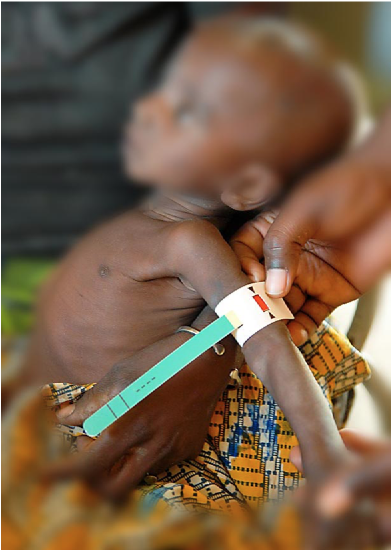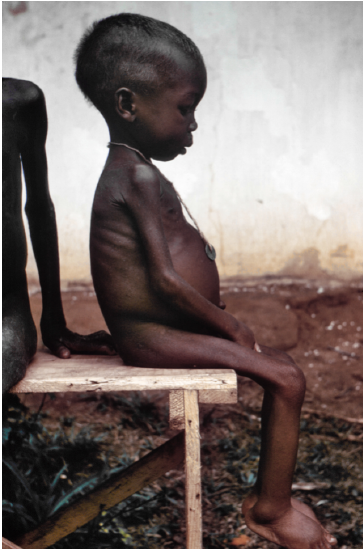4.6: Undernutrition
- Page ID
- 16737
\( \newcommand{\vecs}[1]{\overset { \scriptstyle \rightharpoonup} {\mathbf{#1}} } \)
\( \newcommand{\vecd}[1]{\overset{-\!-\!\rightharpoonup}{\vphantom{a}\smash {#1}}} \)
\( \newcommand{\dsum}{\displaystyle\sum\limits} \)
\( \newcommand{\dint}{\displaystyle\int\limits} \)
\( \newcommand{\dlim}{\displaystyle\lim\limits} \)
\( \newcommand{\id}{\mathrm{id}}\) \( \newcommand{\Span}{\mathrm{span}}\)
( \newcommand{\kernel}{\mathrm{null}\,}\) \( \newcommand{\range}{\mathrm{range}\,}\)
\( \newcommand{\RealPart}{\mathrm{Re}}\) \( \newcommand{\ImaginaryPart}{\mathrm{Im}}\)
\( \newcommand{\Argument}{\mathrm{Arg}}\) \( \newcommand{\norm}[1]{\| #1 \|}\)
\( \newcommand{\inner}[2]{\langle #1, #2 \rangle}\)
\( \newcommand{\Span}{\mathrm{span}}\)
\( \newcommand{\id}{\mathrm{id}}\)
\( \newcommand{\Span}{\mathrm{span}}\)
\( \newcommand{\kernel}{\mathrm{null}\,}\)
\( \newcommand{\range}{\mathrm{range}\,}\)
\( \newcommand{\RealPart}{\mathrm{Re}}\)
\( \newcommand{\ImaginaryPart}{\mathrm{Im}}\)
\( \newcommand{\Argument}{\mathrm{Arg}}\)
\( \newcommand{\norm}[1]{\| #1 \|}\)
\( \newcommand{\inner}[2]{\langle #1, #2 \rangle}\)
\( \newcommand{\Span}{\mathrm{span}}\) \( \newcommand{\AA}{\unicode[.8,0]{x212B}}\)
\( \newcommand{\vectorA}[1]{\vec{#1}} % arrow\)
\( \newcommand{\vectorAt}[1]{\vec{\text{#1}}} % arrow\)
\( \newcommand{\vectorB}[1]{\overset { \scriptstyle \rightharpoonup} {\mathbf{#1}} } \)
\( \newcommand{\vectorC}[1]{\textbf{#1}} \)
\( \newcommand{\vectorD}[1]{\overrightarrow{#1}} \)
\( \newcommand{\vectorDt}[1]{\overrightarrow{\text{#1}}} \)
\( \newcommand{\vectE}[1]{\overset{-\!-\!\rightharpoonup}{\vphantom{a}\smash{\mathbf {#1}}}} \)
\( \newcommand{\vecs}[1]{\overset { \scriptstyle \rightharpoonup} {\mathbf{#1}} } \)
\( \newcommand{\vecd}[1]{\overset{-\!-\!\rightharpoonup}{\vphantom{a}\smash {#1}}} \)
\(\newcommand{\avec}{\mathbf a}\) \(\newcommand{\bvec}{\mathbf b}\) \(\newcommand{\cvec}{\mathbf c}\) \(\newcommand{\dvec}{\mathbf d}\) \(\newcommand{\dtil}{\widetilde{\mathbf d}}\) \(\newcommand{\evec}{\mathbf e}\) \(\newcommand{\fvec}{\mathbf f}\) \(\newcommand{\nvec}{\mathbf n}\) \(\newcommand{\pvec}{\mathbf p}\) \(\newcommand{\qvec}{\mathbf q}\) \(\newcommand{\svec}{\mathbf s}\) \(\newcommand{\tvec}{\mathbf t}\) \(\newcommand{\uvec}{\mathbf u}\) \(\newcommand{\vvec}{\mathbf v}\) \(\newcommand{\wvec}{\mathbf w}\) \(\newcommand{\xvec}{\mathbf x}\) \(\newcommand{\yvec}{\mathbf y}\) \(\newcommand{\zvec}{\mathbf z}\) \(\newcommand{\rvec}{\mathbf r}\) \(\newcommand{\mvec}{\mathbf m}\) \(\newcommand{\zerovec}{\mathbf 0}\) \(\newcommand{\onevec}{\mathbf 1}\) \(\newcommand{\real}{\mathbb R}\) \(\newcommand{\twovec}[2]{\left[\begin{array}{r}#1 \\ #2 \end{array}\right]}\) \(\newcommand{\ctwovec}[2]{\left[\begin{array}{c}#1 \\ #2 \end{array}\right]}\) \(\newcommand{\threevec}[3]{\left[\begin{array}{r}#1 \\ #2 \\ #3 \end{array}\right]}\) \(\newcommand{\cthreevec}[3]{\left[\begin{array}{c}#1 \\ #2 \\ #3 \end{array}\right]}\) \(\newcommand{\fourvec}[4]{\left[\begin{array}{r}#1 \\ #2 \\ #3 \\ #4 \end{array}\right]}\) \(\newcommand{\cfourvec}[4]{\left[\begin{array}{c}#1 \\ #2 \\ #3 \\ #4 \end{array}\right]}\) \(\newcommand{\fivevec}[5]{\left[\begin{array}{r}#1 \\ #2 \\ #3 \\ #4 \\ #5 \\ \end{array}\right]}\) \(\newcommand{\cfivevec}[5]{\left[\begin{array}{c}#1 \\ #2 \\ #3 \\ #4 \\ #5 \\ \end{array}\right]}\) \(\newcommand{\mattwo}[4]{\left[\begin{array}{rr}#1 \amp #2 \\ #3 \amp #4 \\ \end{array}\right]}\) \(\newcommand{\laspan}[1]{\text{Span}\{#1\}}\) \(\newcommand{\bcal}{\cal B}\) \(\newcommand{\ccal}{\cal C}\) \(\newcommand{\scal}{\cal S}\) \(\newcommand{\wcal}{\cal W}\) \(\newcommand{\ecal}{\cal E}\) \(\newcommand{\coords}[2]{\left\{#1\right\}_{#2}}\) \(\newcommand{\gray}[1]{\color{gray}{#1}}\) \(\newcommand{\lgray}[1]{\color{lightgray}{#1}}\) \(\newcommand{\rank}{\operatorname{rank}}\) \(\newcommand{\row}{\text{Row}}\) \(\newcommand{\col}{\text{Col}}\) \(\renewcommand{\row}{\text{Row}}\) \(\newcommand{\nul}{\text{Nul}}\) \(\newcommand{\var}{\text{Var}}\) \(\newcommand{\corr}{\text{corr}}\) \(\newcommand{\len}[1]{\left|#1\right|}\) \(\newcommand{\bbar}{\overline{\bvec}}\) \(\newcommand{\bhat}{\widehat{\bvec}}\) \(\newcommand{\bperp}{\bvec^\perp}\) \(\newcommand{\xhat}{\widehat{\xvec}}\) \(\newcommand{\vhat}{\widehat{\vvec}}\) \(\newcommand{\uhat}{\widehat{\uvec}}\) \(\newcommand{\what}{\widehat{\wvec}}\) \(\newcommand{\Sighat}{\widehat{\Sigma}}\) \(\newcommand{\lt}{<}\) \(\newcommand{\gt}{>}\) \(\newcommand{\amp}{&}\) \(\definecolor{fillinmathshade}{gray}{0.9}\)This photo was taken in the late 1960s. It shows an American volunteer nurse and their patients at an orphanage in Nigeria. The children’s distended bellies are signs of kwashiorkor, a severe form of undernutrition caused by inadequate Calorie and protein intake, usually exacerbated by frequent bouts of infectious disease. Kwashiorkor and other forms of undernutrition still occur at high rates in Nigeria and many other places in the world. Today, one out of every seven people on our planet goes to bed hungry, and 25,000 people a day die of hunger-related diseases. Clearly, undernutrition is still a major problem now as it was then.

Defining Undernutrition
Undernutrition is defined as an insufficient intake of nutritious foods. People who are undernourished are likely to have low body fat reserves, so one indicator of undernutrition in individuals is a low body mass index (BMI). Adults are considered underweight if their body mass index (BMI) is less than 18.5 kg/m2. Children are considered underweight if their BMI is less than the 5th percentile of the reference values for children of the same age.
Undernutrition in Children
The effects of undernutrition are particularly important during childhood when energy and other nutrients are needed for normal growth and development. Children are more likely than adults to become severely undernourished as well as to suffer permanent effects from undernutrition. They may become dangerously thin, with loss of muscle as well as fat. This is called wasting (see figure \(\PageIndex{2}\)). If they lack adequate energy for growth, they will stop growing. If they are chronically undernourished, the growth deficits may cause them to be too short for their age. This is called stunting. Unless adequate nutrition becomes available later so they can make up their growth deficits, stunted children will end up shorter than their genetic potential for height by the time they are adults.

Undernutrition and Infection
Undernutrition and infectious diseases in children have a positive synergistic relationship. Each increases the risk of the other and makes the other worse. Children who are undernourished may be weakened and have a less than robust immune system. This makes them more susceptible to infectious diseases and likely to become sicker when they have infectious diseases. Children who are sick with infectious diseases may need more nutrients to defend against infection. At the same time, they may have reduced intake or absorption of nutrients due to symptoms such as vomiting and diarrhea. In these ways, infectious disease increases the risk of undernutrition or makes existing undernutrition worse.
Undernutrition and Low Birthweight
Many children are born with the disadvantage of low birth weight (< 2.5 kg, or 5.5 lb.) caused by maternal undernutrition and intrauterine growth restriction. Babies with low birth weight are more susceptible to disease and more likely to die in infancy. In children that survive infancy, low birthweight may result in slow growth and developmental delays throughout early childhood.
Undernutrition Syndromes
Severe cases of undernutrition may develop into life-threatening syndromes such as kwashiorkor, as in the Nigerian orphans pictured above. Another common severe undernutrition syndrome is called marasmus.
Kwashiorkor
Kwashiorkor was first described in the medical literature in the 1930s. The name comes from a West African word meaning “disease of the deposed child.” The original meaning of the term is a clue to the cause of this syndrome. If a young child is weaned from the breast so a new baby can be breastfed, the “deposed child” is likely to go from a mostly breastmilk diet, which is high in protein, to a mostly plant-food diet, which is low in protein. Although Kwashiorkor may occur in a child who lacks protein but not Calories, it occurs more often when the diet is also deficient in Calories. That’s why kwashiorkor is commonly called protein-Calorie malnutrition.
The defining sign of kwashiorkor in an undernourished child is edema (swelling) of the ankles and feet and often a distended belly, both of which are clearly visible in the child pictured below. The lack of protein causes osmotic imbalances that prevent tissue fluids from being returned to the bloodstream. This mechanism accounts for the accumulation of fluid in the ankles, feet, and abdomen. Other common signs of kwashiorkor include enlarged liver (which contributes to the abdominal distension), thinning hair, loss of teeth, skin rash, and skin and hair depigmentation. Children with kwashiorkor may also be irritable and lose their appetite. Kwashiorkor can have a long-term impact on a child's physical and mental development and frequently leads to death without treatment.

Marasmus
Marasmus comes from a Greek word meaning “wasting away.” It is a severe undernutrition syndrome caused by extremely low intakes of food energy. Signs and symptoms of marasmus include wasting (as depicted above, low body temperature, anemia, dehydration, weak pulse, and cold extremities. Without treatment, marasmus is often fatal, although it generally has a better prognosis than untreated kwashiorkor.

Micronutrient Deficiencies
Besides deficiencies in food energy and protein, many undernourished people suffer from deficiencies of specific vitamins or minerals. Some of the most common micronutrient deficiencies worldwide are iron, vitamin A, and iodine deficiencies.
Iron Deficiency
Iron deficiency is the single most common micronutrient deficiency worldwide, affecting about 2 billion people. Iron deficiency, in turn, causes anemia, which is especially common in women and children under the age of five years. Anemia can lead to increased mortality in infancy and poor cognitive and motor development in early childhood. The problems caused by iron-deficiency anemia in childhood cannot be reversed.
Vitamin A Deficiency
Vitamin A deficiency is also very common in developing countries. In young children, vitamin A plays an essential role in the development of the immune system, so vitamin A deficiency adversely affects the ability of the immune system to fight off infections. Vitamin A deficiency also contributes to anemia and causes visual impairments, ranging from night blindness (inability to see well at low light levels) to total blindness.
Iodine Deficiency
Since the early 1900s, iodine has been added to salt in many countries, including the United States and most of Europe, virtually eliminating iodine deficiency in these countries. However, inadequate iodine intake is still a public health problem in dozens of countries, and about 30 percent of the world’s people are iodine deficient.

Iodine is needed for thyroid hormone production. In adults, iodine deficiency causes reversible signs and symptoms of inadequate thyroid hormone. These may include an enlarged thyroid gland, called a goiter (see the photo above), and a sluggish metabolism. In children, iodine deficiency is much more serious. It causes permanent intellectual disability because thyroid hormone is needed for normal brain growth and development, from the fetal stage through early childhood. Iodine deficiency is the most important cause of preventable intellectual disability in the world.
Causes of Undernutrition
A small percentage of undernutrition occurs because of diseases such as cancer, anorexia nervosa, celiac disease, and cystic fibrosis (all of which you can read about in other concepts). However, the vast majority of undernutrition globally occurs because people simply don’t have enough nutritious food to eat. They take in less energy than the minimum daily energy requirement so they are underweight, and they are likely to have other nutritional deficiencies as well.
Worldwide food supplies are adequate to provide food to all if the food supplies were equally distributed and accessible to everyone. Unfortunately, that is not the case. Adequate food is not available to people over large areas of Africa and Asia. Even if food supplies were equally distributed, most undernutrition would still occur in these areas because of the inability of many people to access food due to poverty. Poverty is a consequence as well as a cause of undernutrition, and the two form a self-perpetuating cycle. Impoverished individuals are less likely to have access to enough nutritious food for good health and for normal growth and development. As a result, they are more likely to be undernourished. Undernutrition, in turn, makes them less likely to attend or perform well in school and as adults to be less productive workers, thus limiting their income.

Although undernutrition is not as common in the richer nations of the world as it is elsewhere, it still occurs in significant proportions of people. Even in a land of plenty like the United States, socioeconomic disparities result in some people being undernourished due to lack of access to sufficient nutritious food. The photo below, taken in New York City, shows a woman searching for edible food in a garbage dumpster. Besides lacking adequate money to buy nutritious foods, many poor people in the United States live in areas that are considered “food deserts,” defined as areas with limited access to nutritious foods. In these food deserts, supermarkets with fresh produce and other nutritious food choices are typically too far away for people to utilize. Instead, they must rely on small neighborhood stores that stock mainly over-priced processed foods or on fast food restaurants that offer primarily high-fat and high-sugar food options. With social inequalities on the rise in the United States and some other rich nations, problems of food access and undernutrition may worsen.

Treatment and Prevention of Undernutrition
Treating and preventing undernutrition is a huge and complex problem requiring multifaceted approaches. Potential solutions must target both individual and public health. Meeting individual needs is generally achieved through direct nutrition interventions (like the one illustrated in the photo above). In such interventions, the health-care sector typically delivers nutritional supplements directly to acutely malnourished people who might otherwise require hospitalization. Public health interventions may focus on improvements in agriculture, water, sanitation, or education, among other public health targets. Some of the most successful public health interventions have been those aimed at eliminating specific micronutrient deficiencies. For example, in the early 1990s, iodine deficiency was addressed by a global campaign to iodize salt. This campaign reduced the rate of iodine deficiency from about 70 percent to 30 percent.

Review
- Define undernutrition.
- How is underweight status determined in adults? How is it determined in children?
- Why is undernutrition a more significant problem in children than adults?
- What are wasting and stunting?
- Describe kwashiorkor.
- What is marasmus?
- List three of the most common micronutrient deficiencies worldwide. Describe how each deficiency affects health.
- Why do the vast majority of cases of undernutrition occur?
- Explain how undernutrition and poverty are related.
- Why does undernutrition occur even in the richer nations of the world?
- How should the problem of global undernutrition be tackled?
- Which best describes the relationship between undernutrition and infectious disease?
- Undernutrition can increase the risk of infectious disease.
- Infectious disease can increase the risk of undernutrition.
- Undernutrition and infectious disease are independent of one another.
- A and B
- True or False. A diet that has enough energy but is deficient in protein can result in a type of undernutrition syndrome.
- True or False. The distended belly seen in kwashiorkor is due primarily to the stomach expanding in response to lack of food in it.
Explore More
Attributions
- Kwashiorkor by CDC, public domain via Wikimedia Commons
- Worldvision muac by World Vision Deutschland, licensed CC BY 3.0 via Wikimedia Commons
- Starved girl by Dr. Lyle Conrad for CDC, public domain via Wikimedia Commons
- Girl affected by famine by Fridtjof Nansen, public domain via Wikimedia Commons
- Woman with goiter by Martin Finborud, public domain via Wikimedia Commons
- Hunger map by Allice Hunter, licensed CC BY-SA 4.0 via Wikimedia Commons
- Royal food NY by Carlos. A. Martinez, licensed CC BY 2.0 via Wikimedia Commons
- Children receive PlumpyNut nutritional aid by USAID Africa Bureau, public domain via Wikimedia Commons
- Text adapted from Human Biology by CK-12 licensed CC BY-NC 3.0


